|
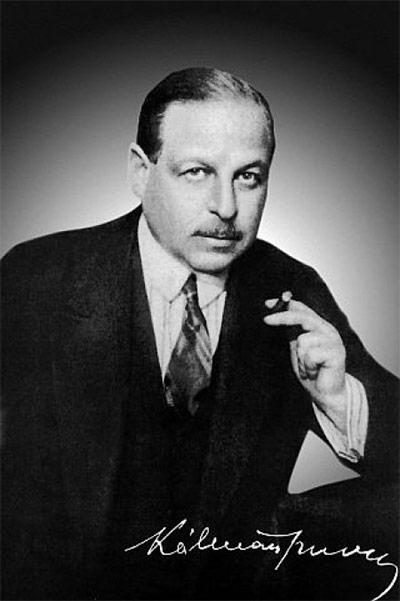
Imre Kalman
Emmerich (Imre) Kalman, one of the greatest composers of operetta, was born in Siofok, Hungary, 1882.
Siófok had started to become a major bathing place in the decade before Emmerich Kalman was born. Looking at the history of the city, one can see that the years before the composer’s birth had special significance. Taking 1863 as the year when the town became a holiday destination, the Budapest-Fiume train line comes to mind first. More and more people realised that the lakeshore at Siófok and its silky sand was excellent for bathing for any age group. This revelation was the impetus for the development of the town into a spa destination. The main occupation of the population at the time was farming, livestock production and trade. No wonder Károly Eötvös stated that “all signs point to Siófok being blessed for the future.” Jewish migrants gave a boost to commerce in town. Numerous commercial interests had been realized in the development of the town into a spa destination. At the same time when the “Franz Joseph Southeast Railway” was built, river control measures for Sió were launched, while at the same time the construction of the spa facility had begun.
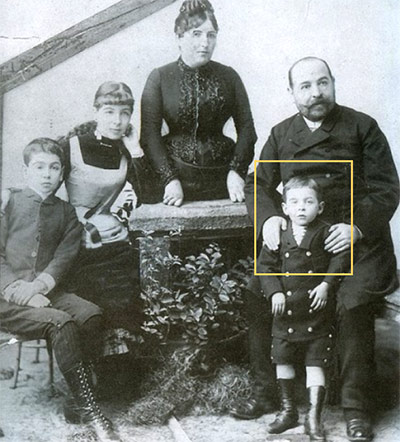
The father of Emmerich Kalman, Károly Koppstein was a grain trader and contractor. The mother, Paula Singer, a sweet-tempered, artistic woman had lived to witness the international fame of her son. Emmerich Kalman was born as the third child in the family. There were six siblings. Emmerich Koppstein changed his last name to
Kalman during the secondary school years.
When he was a child, he was surrounded by the folklore of the Balaton region. Little Emmerich gave proof of his exceptional musical talent as early as the age of five. Even much earlier than that, however, he had listened to piano-playing by his mother and his aunt Vilma, actively participating. He would crouch in the corner of the sofa and listen with an earnestness defying his age, his eyes reflecting deep empathy.
Occasionally, his face was sometimes pale with emotion, other times flushed with excitement. He had not only the piano available in his parents’ house, he had innate talent. His mother’s family included first-class musicians, while the father’s lineage had excellent rabbis and teachers.
The following episode best describes how early his interest in music became evident: “On one occasion, I went to their place to play, but Emmerich was nowhere to be seen. A cousin (10 years his senior) was playing the piano. The cover on the piano was long enough to reach the floor. That’s where Emmerich had hidden”, remembered his childhood friend, Jenő Fischer. Siófok oral history preserved the following story. Emmerich Kalman as a child marched on the town market square drumming loudly, enjoying how the animals, startled, scattered in all directions before him. His steps were shadowed by clucking, grunts, cackling and barking. All these noises amounted to different tones for the ears of the little musician, full of sharp dissonances, a variety of rhythm and dynamics, and the dramatic uniting force of the drumbeat. There you have it, the first symphonic epic, born out of a child’s unbound fantasy: with an orchestra of animals and a little conductor using his drumsticks as the conductor’s baton.
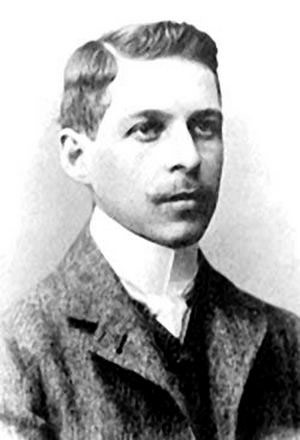
Kalman’s environment also included the Siófok acting scene which had begun in 1875 and featured several major figures. At the pinnacle of his career, Emmerich Kalman remembered his first encounter with music and the world of musicians. In the summer of 1888, the many renowned visitors included violinist Ferenc Liedl (1856-1900). He rented a room from
Kalman’s family to have a place for undisturbed musical practice sessions. Emmerich Kalman as a child took music lessons from Liedl for the first time. He also first encountered theatre in his youth in Siófok. He kept nosing around the Summer Theatre (founded by Lipót Karpelesz) in the direct vicinity of their home. Although uninvited, Emmerich Kalman turned up on time for every rehearsal. He even had the courage to go backstage. He was mesmerised and enchanted by the world of theatre.
He attended a small, one-teacher Israelite school for his primary school studies. The Jewish school in Siófok had a very good reputation, Christian parents were also happy to send their children here. The reason was not only the excellent teacher, Adolf Rónai, who was recognised by the entire town, but also the fact that this school also taught German. At this school, Emmerich Kalman had Géza Révész as his schoolmate, who later became a psychologist of international fame.
Emmerich Kalman took his first piano lessons from Mrs. Antalné Nemcsák, the Siófok art teacher, back in the primary school years. He attended secondary school in Budapest, in the Deák Square Lutheran Secondary School. One of the rooms in the Emmerich Kalman Memorial Home is the true reflection of the age when the future master composer of the operetta genre lived as a child, as a youth. Some photographic documents, including the portrait of Franz Joseph, evoke the times when a gentlemanlike lifestyle consisted of attending the casino, the theatre and the horse races, a time that was also characterised by operettas, the rebirth of picaresque novels, sentimental short stories and crime novels alike.
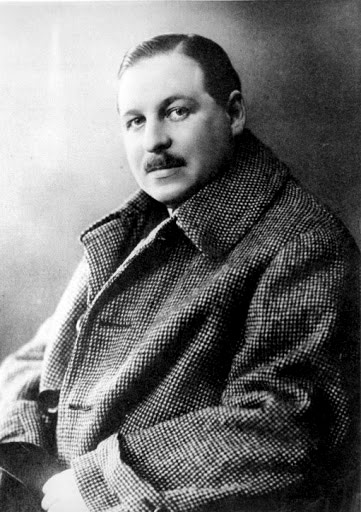
The exhibition showcasing the history of the age and that of the operetta genre exudes the ambiance of the early 20th century. It also provides an authentic, human image of Emmerich Kalman, who started his career in this house, who had spent his childhood and early years as a pupil here. Even at the pinnacle of his career, he had not broken his ties with Siófok.
The exhibition enables us to witness the start of Emmerich Kalman’s career as a musician on the tableaus and photographs. By the age of sixteen, he had been able to save enough money to replace the old piano - sold in the interim - with a second-hand one. He cherished this Csuport-made instrument; he never wanted to sell it. Later on, the family kept it safe; it stood in his mother’s room for a long time, then his younger sister Rózsika had it for safekeeping, and in the end the widow donated it to the Emmerich Kalman Museum of Siófok. Now this piano stands in the first room of the memorial home. This old musical instrument could really tell stories about the Emmerich Kalman who had given up his career as a concert pianist, studying composition and becoming a lawyer as a result of pressure by the family. The piano could probably even tell a story about the young man who shut the lid in anger, who made up his mind to commit the “monstrous act” of composing operettas. The armchair and the chandelier are also original pieces. The piano stool was donated to the museum by Mr. János Halperth, the grandson of
Kalman’s sister, Vilma.
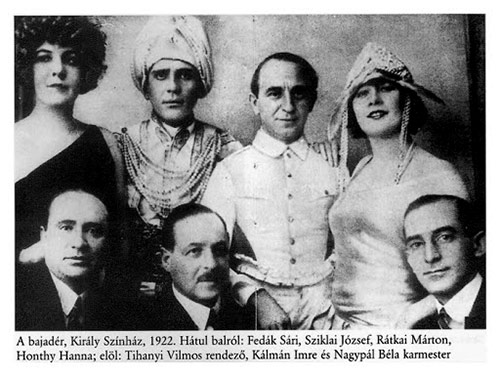
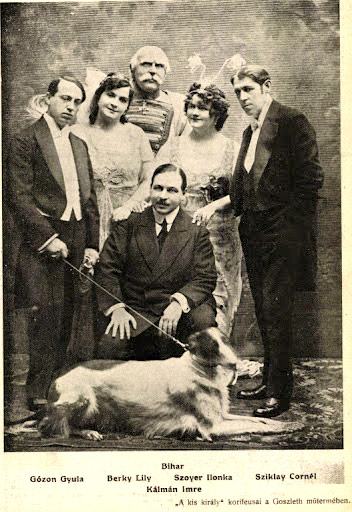
The exhibition centers on the bust of Emmerich Kalman, created by the famous Paris sculptor, E. D. Minazzoli in 1953, of Carrara marble. The excellent characterisation is a true reflection of the purposefulness and struggles of the young artist, the disappointment over the minor setbacks and the final grasp of success.
The exhibition also reveals the fact that Kalman enrolled at the Academy of Music as early as the age of 15. He was a student of János Koessler, who also taught Bartók, Kodály, Dohnányi, Weiner, Albert Szirmai and Viktor Jacobi. In the meantime, he had also studied law at the university in Budapest, then he became the head music columnist for the paper Pesti Napló. He worked for them for five years, while also publishing articles in Új Idők. He wrote the cabaret songs “AS BERTA IS SHORT OF BRAINS” and “SÁRI FEDÁK’S MAID” while working as a critic. At a later stage, he was ashamed of these songs, as he had dreamed of symphonies while attending the class of Professor Koessler at the Academy of Music. As a child, he had wanted to become a concert pianist, but soon he had to give up those ambitions because of chronic arthritis in his hand. After graduation from the Academy of Music, he tried to find a publisher in Vienna, in Munich and Leipzig for his songs and symphonic poems, but did not succeed.
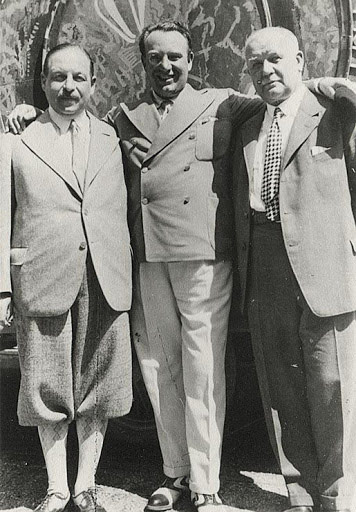
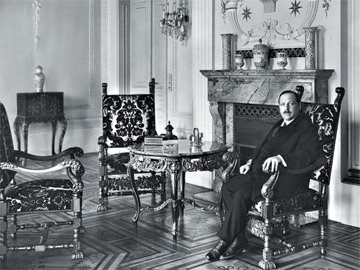
During this period he had written music for Samu Fényes’ musical play titled A PERESZLÉNYI JUSS (The Inheritance in Pereszlény), which was performed on stage only six times. “If things go on like this, I’ll commit a monstrous act... I’ll write an operetta!”, he threatened. His first major success was TATÁRJÁRÁS (The Gay Hussars), which premiered on 2 February, 1908 in the Comedy Theatre. Tatárjárás was performed 144 times, and soon enough, it was also staged in Vienna and in Prague.
The Vienna debut was considered a huge success as at that time Vienna was the capital of the operetta genre.
Kalman soon moved to Vienna (it is widely understood that the bourgeois in the Austro-Hungarian Monarchy felt equally at home in Budapest, Vienna and Prague). The composer was 25 years old at that point. One year later, The Gay Hussars was performed in Moscow, New York, London and Rome, and it was the first Hungarian operetta to be staged in France as well. The libretto was penned by Austrian librettists Alfred Grünwald, Julius Brammer, Rudolf Oesterreicher, and the premieres were held in Johann Strauss Theater in Vienna and in Theater an der Wien.
The premieres in Budapest were in chronological order as follows:
AZ OBSITOS (“THE SOLDIER ON LEAVE”, 1910),
A CIGÁNYPRÍMÁS (“THE GYPSY VIRTUOSO”, 1914),
A KIS KIRÁLY (“THE LITTLE KING”, 1914),
ZSUZSI KISASSZONY (“MISS SPRINGTIME”, 1915),
A CSÁRDÁSKIRÁLYNŐ (“THE CSÁRDÁS PRINCESS”, 1916),
A FARSANG TÜNDÉRE (“MISS SUZY”, 1919),
A HOLLANDI MENYECSKE (“THE DUTCH GIRL”, 1921),
A BAJADÉR (“THE YANKEE PRINCESS”, 1922),
MARICA GRÓFNŐ (“COUNTESS MARITZA”, 1924),
A CIRKUSZHERCEGNŐ (“THE CIRCUS PRINCESS”, 1926),
A CSIKÁGÓI HERCEGNŐ (“THE DUCHESS OF CHICAGO”, 1928)...
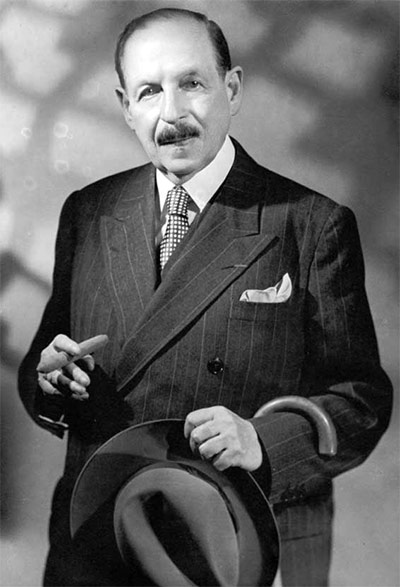
After the two successful “princess operettas”, Emmerich Kalman had a major change in his life: he got married. The very young dancer of radiant beauty, of Russian and Polish origin,
Vera Maria Makinszka became his wife.
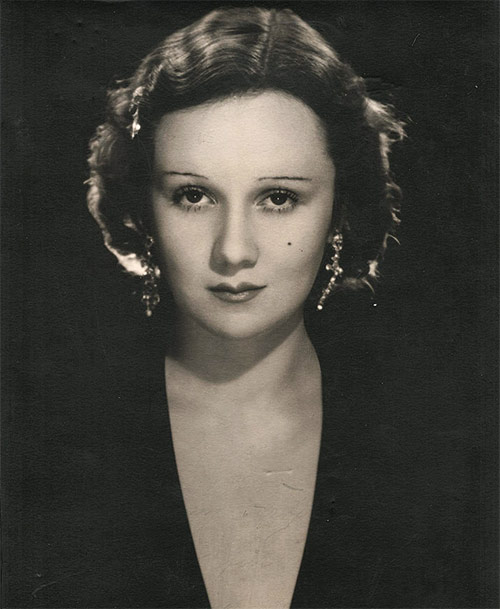
Vera Kalman
They had two daughters, Lily and Yvonne, and a son, Charles. Kalman, as evidenced by the images, became a happy husband and father. He was probably busy with his family life and the arrangements, orders, reviews and clerical issues related to his operettas being staged all around the world.
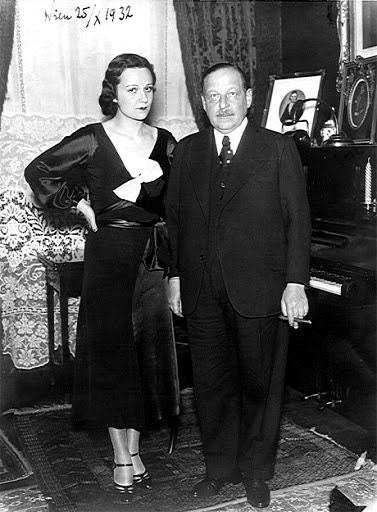
After The Duchess of Chicago, he presented another operetta only six year later, ÖRDÖGLOVAS (THE DEVIL’S RIDER), in 1934. It was followed by A MONTMARTRE-I IBOLYA (“PARIS IN SPRING”, 1935) and JOSEPHINE CSÁSZÁRNŐ (“EMPRESS JOSEPHINE”, 1937)... They were all successful, but The Csárdás Princess is his masterpiece. The second room of the exhibition showcases the bar scene from The Csárdás Princess. The “protagonists” are in period costumes, sitting in the box seats to invoke the original ambience.
The debut for The Csárdás Princess in Vienna was on 17 November, 1915. The Hungarian run started a year later, in Király Theatre, on November 3, 1916. The last Hungarian premiere for
Kalman was in 1937, in Városi Színház, when the title role for Empress Josephine was sang by the star of European opera houses of the time, Mária Németh.
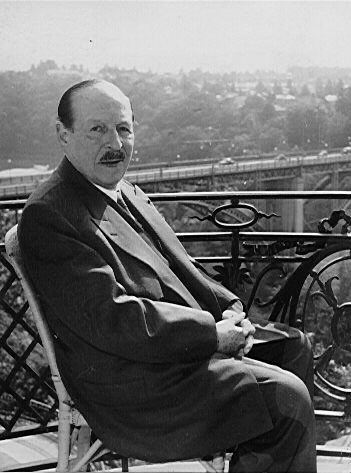
The display cabinets contain original archive photographs and some Emmerich Kalman memorabilia. These items were moved to Siófok from the Vienna Hofburg and the Theatre Museum, received as a donation by Vera
Kalman. This cabinet shows Emmerich Kalman’s personal items; his ashtray, pencil-sharpener, wallet, pencilbox, letter scale, signature stamp, envelope holder, notepad etc. Note the genuine gypsum copies of Emmerich Kalman’s hands — these hands wrote the sheet music with those unforgettable tunes. One’s fate is reflected first and foremost in the face, second in the hands. A valuable piece of memorabilia is the “Kruckenkreuz”, a high-profile Austrian decoration, received from Austrian Chancellor Dolfuss. The outbreak of the war brought sadness and dark times for the composer. He had to leave Vienna. First, he moved to Paris, later to America. He only returned to Europe after the war, and as a lifetime achievement award for his music, he received the officers’ cross of the Legion of Honour from Joseph Paul-Bencour in Paris, on 11 April, 1953. He did not live to see the premiere of his last operetta, the Arizona Lady. He died in the French capital, on October 30, 1953. He was buried according to his wishes, in Vienna, in the Zentralfriedhof.
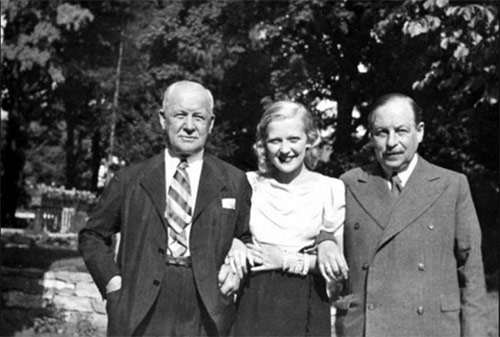
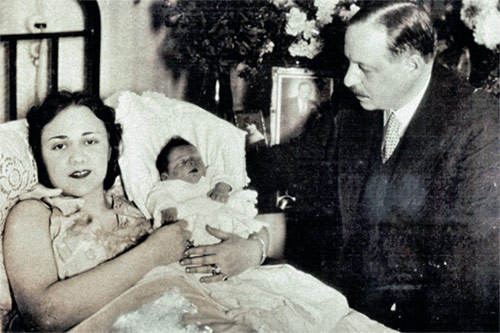
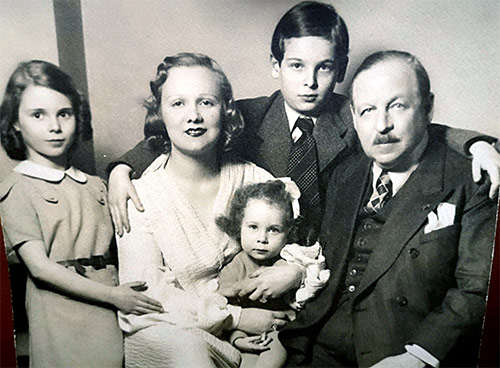
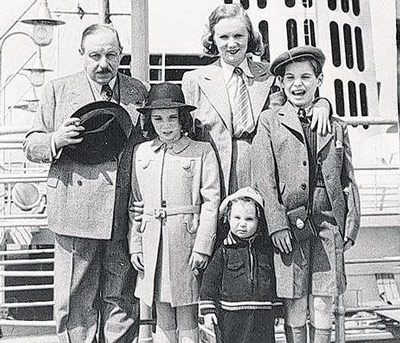
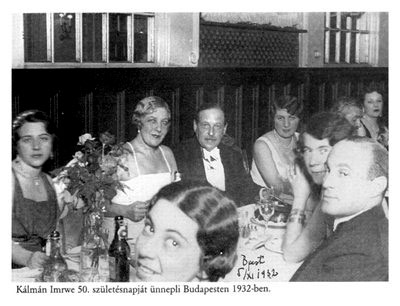
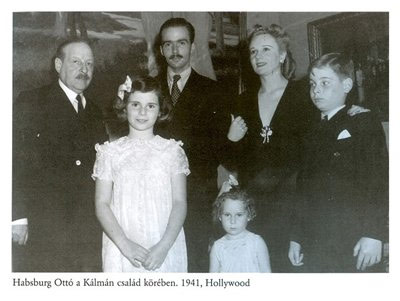
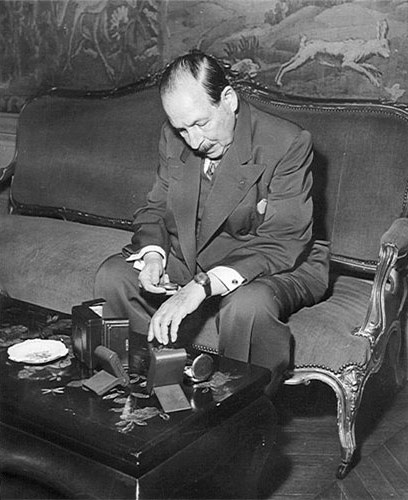
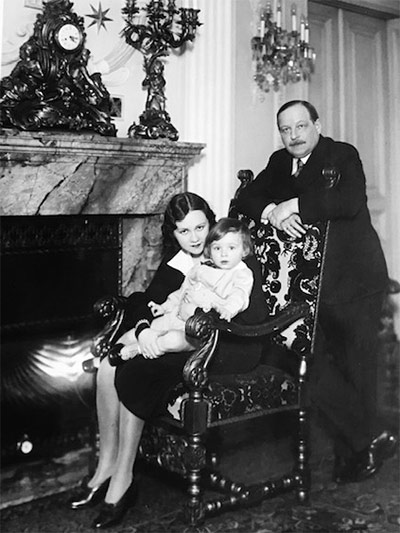
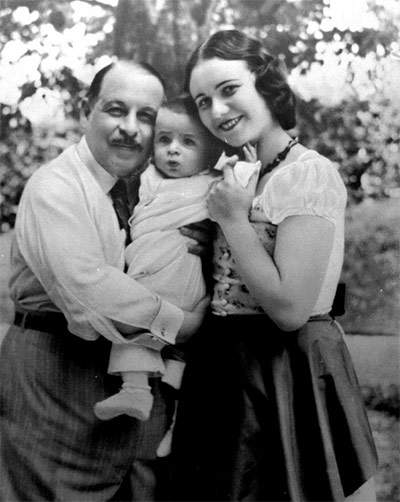
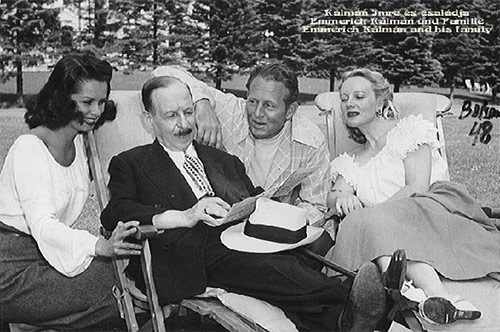
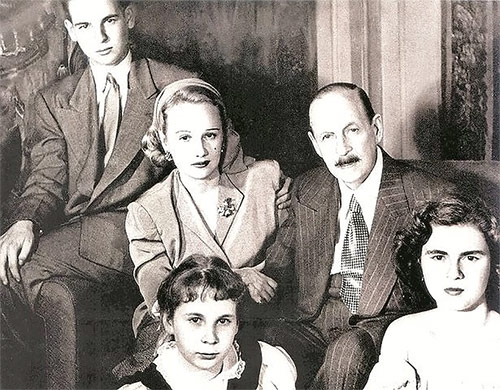
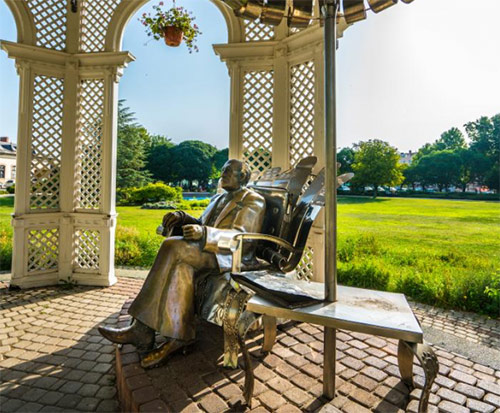 |